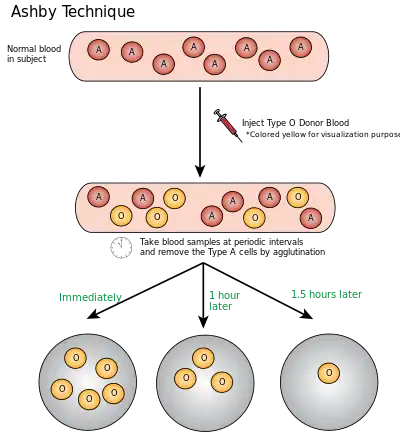
The Ashby technique is a method for determining the volume and life span of red blood cells in humans, first published by Dr. Winifred Ashby in 1919.[1] The technique involves injection of compatible donor red blood cells of a different blood group into a recipient, followed by blood testing periodically afterwards. Differential agglutination of the red cells is then used to determine the number of remaining donor cells, allowing the survival rate to be determined. It does not involve radioisotope technology, and was the first technique to successfully establish the correct red blood cell life span. In particular, Type O blood is first transfused into Type A or B subjects. In subsequent blood samples, the patient's own A and B blood cells are removed by agglutination with either anti-A or anti-B serum. The number of remaining nonagglutinated Type O cells as a function of time defines the survival rate of blood cells.[2] This technique was used extensively during World War II and shortly after but has more recently been replaced by techniques that label one's own blood, due of the dangers of using donor blood.[3]
References
- ↑ Winifred, Ashby (1919). "The Determination of the Length of Life of Transfused Blood Corpuscles in Man". J Exp Med. 29 (3): 267–281. doi:10.1084/jem.29.3.267. PMC 2126347. PMID 19868318.
- ↑ Franco RS (February 2009). "The measurement and importance of red cell survival". Am. J. Hematol. 84 (2): 109–14. doi:10.1002/ajh.21298. PMID 19025796.
- ↑ Lichtman, Marshall (2005-10-14). Williams Hematology (7th ed.). McGraw-Hill Professional. ISBN 978-0-07-143591-8.
Further reading
- Winifred, Ashby (1919). "The Determination of the Length of Life of Transfused Blood Corpuscles in Man". J Exp Med. 29 (3): 267–281. doi:10.1084/jem.29.3.267. PMC 2126347. PMID 19868318.
- Winifred A. (1921). "Study of Transfused Blood: I. The Periodicity in Eliminative Activity Shown by the Organism". J. Exp. Med. 34 (2): 127–146. doi:10.1084/jem.34.2.127. PMC 2128080. PMID 19868544.
- Winifred A. (1921). "Study of Transfused Blood: Ii. Blood Destruction in Pernicious Anemia". J. Exp. Med. 34 (2): 147–166. doi:10.1084/jem.34.2.147. PMC 2128079. PMID 19868545.